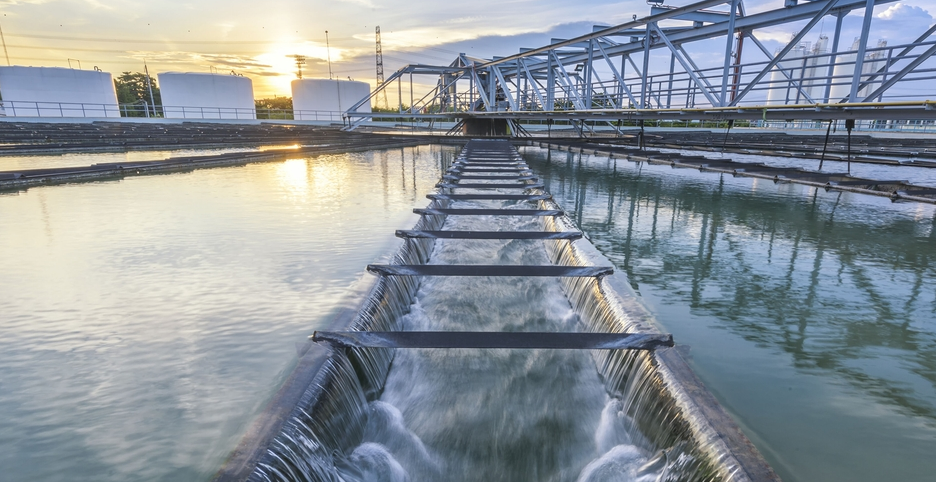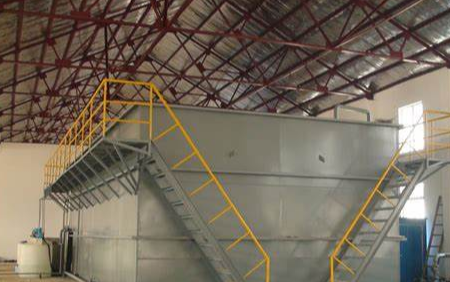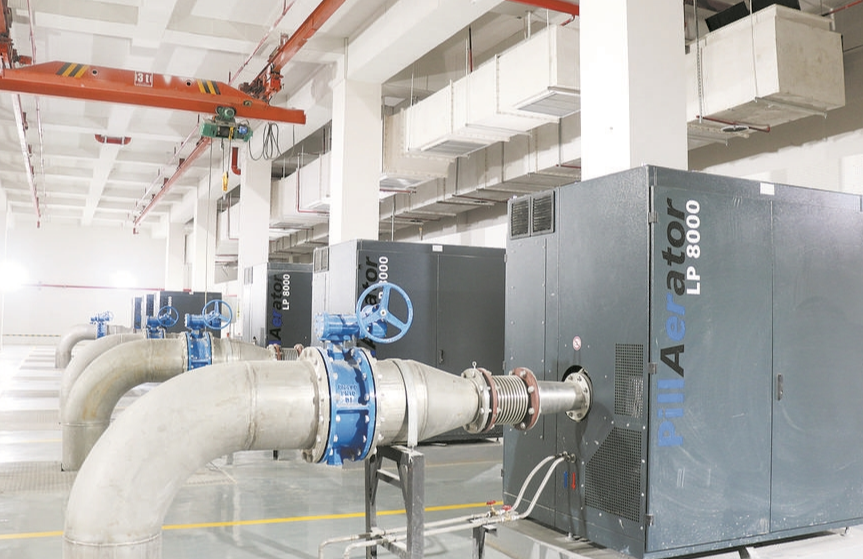What are the advanced sewage treatment technologies today?
Membrane technology Membrane separation methods are commonly used microfiltration, nanofiltration, ultrafiltration and reverse osmosis and other technologies. Because membrane technology does not introduce other impurities in the treatment process, it can realize the separation of large molecules and small molecules, so it is often used for the recovery of various large molecular raw materials, such as the use of ultrafiltration technology to recover polyvinyl alcohol slurry of printing and dyeing wastewater. At present, the main difficulties that limit the application and popularization of membrane technology are high cost, short life, easy to be polluted and blocked by scale. With the development of membrane production technology, membrane technology will be more and more applied in the field of wastewater treatment. Magnetic separation technology Magnetic separation technology is a new water treatment technology developed in recent years, which uses the magnetic separation of impurity particles in wastewater. For non-magnetic or weakly magnetic particles in water, magnetic inoculation technology can be used to make them magnetic.

There are three methods of magnetic separation technology used in wastewater treatment: direct magnetic separation method, indirect magnetic separation method and microbial magnetic separation method. At present, the magnetization technology mainly includes magnetic agglomeration technology, ferric salt co-sedimentation technology, iron powder method, ferrite method, etc. The representative magnetic separation equipment is disk magnetic separator and high gradient magnetic filter. At present, magnetic separation technology is still in the laboratory research stage and can not be applied to practical engineering practice. The typical Fenton reagent of Fenton and Fenton-like oxidation processes is produced by the decomposition of H2O2 catalyzed by Fe2+ to produce •OH, which leads to the oxidative degradation of organic matter. As Fenton process takes a long time to treat wastewater, it uses a large number of test doses, and excessive Fe2+ will increase COD in the treated wastewater and produce secondary pollution. In recent years, ultraviolet light and visible light have been introduced into the Fenton system, and other transition metals have been studied to replace Fe2+. These methods can significantly enhance the oxidative degradation ability of Fenton reagent on organic matter, reduce the amount of Fenton reagent and reduce the treatment cost, collectively referred to as Fenton-like reaction. Fenton process has mild reaction conditions, simple equipment and wide application range. It can be used as a separate treatment technology, or combined with other methods, such as coagulation precipitation, activated carbon, biological treatment, etc., as a pretreatment or advanced treatment method of refractory organic wastewater. Ozone oxidation Ozone is a strong oxidizing agent, fast reaction with reduced pollutants, easy to use, does not produce secondary pollution, can be used for sewage disinfection, color removal, deodorization, removal of organic matter and reduce COD. Using ozone oxidation alone is expensive and expensive, and its oxidation reaction is selective, and the oxidation effect on some halogenated hydrocarbons and pesticides is relatively poor. To this end, in recent years, the development of related combination technologies aimed at improving the efficiency of ozone oxidation, in which UV/O3, H2O2/O3, UV/H2O2/O3 and other combination methods can not only improve the oxidation rate and efficiency, but also can oxidize organic matter that is difficult to oxidize and degrade when ozone acts alone. Due to the low solubility of ozone in water, low production efficiency and high energy consumption, increasing the solubility of ozone in water, improving the utilization rate of ozone, and developing high efficiency and low energy consumption ozone generation devices have become the main research directions. Wet (catalytic) oxidation Wet (catalytic) oxidation method is at high temperature (150~350℃), high pressure (0.5~20 MPa), under the action of catalysts, the use of O2 or air as an oxidizing agent (add catalyst), (catalytic) oxidation of dissolved or suspended organic matter or reduced inorganic matter in the water, to achieve the purpose of removing pollutants.

Wet air (catalytic) oxidation method can be applied to the treatment of municipal sludge and industrial wastewater such as acrylonitrile, coking, printing and dyeing, and pesticide wastewater containing phenols, chlorohydrocarbons, organophosphorus and organic sulfur compounds. Plasma water treatment technology Low temperature plasma water treatment technology, including high voltage pulse discharge plasma water treatment technology and glow discharge plasma water treatment technology, is the use of discharge directly in the aqueous solution to produce plasma, or the active particles in the gas discharge plasma into the water, can make the pollutants in the water thoroughly oxidized, decomposed. The direct pulse discharge in aqueous solution can be operated at normal temperature and pressure, and the chemical oxidizing species in situ can be oxidized and degraded organic matter in aqueous solution without adding catalyst during the whole discharge process. This technology is economical and effective for the treatment of low concentration organic matter. In addition, the type of reactor using pulsed discharge plasma water treatment technology can be flexibly adjusted, the operation process is simple, and the corresponding maintenance cost is low. Due to the limitation of discharge equipment, the energy efficiency of this process to degrade organic matter is low, and the application of plasma technology in water treatment is still in the research and development stage. Electrochemical (catalytic) oxidation Electrochemical (catalytic) oxidation technology directly degrades organic matter through anodic reaction, or produces oxidizing agents such as hydroxyl radicals (•OH) and ozone to degrade organic matter through anodic reaction. Electrochemical (catalytic) oxidation includes one -, two - and three-dimensional electrode systems. Due to the micro-electric field electrolysis of three-dimensional electrode system, it has been highly respected. The three-dimensional electrode is filled with granular or other detritus working electrode material between the electrodes of the traditional two-dimensional electrolytic cell, and the surface of the loaded material is charged to become the third pole, and the electrochemical reaction can occur on the surface of the working electrode material. Compared with the two-dimensional flat electrode, the three-dimensional electrode has a large specific surface, can increase the surface ratio of the electrolyzer, can provide a larger current intensity at a lower current density, small particle spacing and high mass transfer speed, high space-time conversion efficiency, so the current efficiency is high and the processing effect is good.

Three-dimensional electrodes can be used to treat domestic sewage, pesticides, dyes, pharmaceuticals, phenolic wastewater and other difficult to degrade organic wastewater, metal ions, landfill leachate and so on. The organic pollutants in water irradiated by ultrasonic wave with frequency of 15~1000kHz is a physicochemical process caused by cavitation effect. Ultrasonic can not only improve the reaction conditions, speed up the reaction speed and increase the reaction yield, but also make some difficult chemical reactions to be realized. It integrates the characteristics of advanced oxidation, incineration, supercritical oxidation and other water treatment technologies in one, coupled with simple operation, low requirements for equipment, in sewage treatment, especially in the degradation of wastewater toxicity, difficult to degrade organic pollutants, accelerate the degradation rate of organic pollutants, to achieve harmless industrial wastewater pollutants, to avoid the impact of secondary pollution is of great significance. In recent years, more and more researches have been conducted on the direct or intensive treatment of organic wastewater by ultrasonic wave, including degradation mechanism, kinetics, intermediates, influencing factors and system optimization. Radiation technology Since the 1970s, with the development of large cobalt sources and electron accelerator technology, the radiation source problem in the application of radiation technology has gradually improved. The use of radiation technology to treat pollutants in wastewater has attracted the attention of many countries. Compared with traditional chemical oxidation, the use of radiation technology to treat pollutants does not need to add or only a small amount of chemical reagents, does not produce secondary pollution, has the advantages of high degradation efficiency, fast reaction speed, and thorough degradation of pollutants. Moreover, when ionizing radiation is used in combination with catalytic oxidation means such as oxygen and ozone, a "synergistic effect" will be produced. Therefore, radiation technology to deal with pollutants is a clean and sustainable technology, which is listed as the main research direction of peaceful use of atomic energy in the 21st century by the International Atomic Energy Agency. Photochemical catalytic oxidation Photochemical catalytic oxidation technology is developed on the basis of photochemical oxidation, compared with the photochemical method, has a stronger oxidation capacity, can make organic pollutants more thoroughly degraded. Photochemical catalytic oxidation is a photochemical degradation in the presence of catalysts, and the oxidant produces free radicals with strong oxidation capacity under the radiation of light. The catalysts are TiO2, ZnO, WO3, CdS, ZnS, SnO2 and Fe3O4.

Homogeneous photocatalytic degradation is based on Fe2+ or Fe3+ and H2O2 as the medium, and hydroxyl free radicals are produced by photoassisted Fenton reaction to degrade pollutants. Heterogeneous catalytic degradation is to put a certain amount of photosensitive semiconductor materials in the pollution system, such as TiO2, ZnO, and so on, combined with light radiation, so that the photosensitive semiconductor excited under light irradiation to produce electron-hole pairs, dissolved oxygen, water molecules adsorb on the semiconductor and electron-hole interaction, resulting in •OH and other strong oxidation ability of free radicals. TiO2 photocatalytic oxidation technology has obvious advantages in oxidizing and degrading organic pollutants in water, especially difficult to degrade organic pollutants. SCWO (Supercritical water oxidation) technology SCWO uses supercritical water as the medium to decompose organic matter by homogeneous oxidation. Organic pollutants can be decomposed into small inorganic molecules such as CO2 and H2O in a short time, while sulfur, phosphorus and nitrogen atoms are converted into sulfate, phosphate, nitrate and nitrite ions or nitrogen, respectively. The United States lists the SCWO process as the most promising waste treatment technology in the field of energy and environment. SCWO has fast reaction rate and short residence time. High oxidation efficiency, most organic matter treatment rate can reach more than 99%; The reactor structure is simple and the equipment size is small. Wide range of treatment, not only can be used for a variety of toxic substances, wastewater, waste treatment, can also be used to decompose organic compounds; No need for external heating, low processing cost; Good selectivity, by adjusting the temperature and pressure, can change the density of water, viscosity, diffusion coefficient and other physical and chemical characteristics, so as to change its solubility of organic matter, to achieve the purpose of selective control of reaction products. The supercritical oxidation method has been applied in the United States, Germany, Sweden, Japan and other European and American countries, but the research in China started late and is still in the laboratory research stage. Iron-carbon microelectrolysis is a good process for wastewater treatment using the reaction principle of Fe/C galvanic cells, also known as internal electrolysis, iron filings filtration, etc.

The iron-carbon microelectrolysis method is a comprehensive effect of electrochemical REDOX, electrochemical electroconcentration of floc, condensation of electrochemical reaction products, adsorption of new floc and bed filtration, among which REDOX, electric adhesion and condensation are the main effects. When the iron filings are immersed in the wastewater containing a large number of electrolytes, countless tiny galvanic cells are formed. After the coke is added to the iron filings, the iron filings contact with the coke particles to further form large galvanic cells, so that the iron filings are corroded on the basis of micro galvanic cells and corroded by large galvanic cells, thus speeding up the electrochemical reaction. This method has many advantages, such as wide application range, good treatment effect, long service life, low cost and easy operation and maintenance, and uses waste iron filings as raw materials, and does not need to consume power resources, and has the significance of "treating waste with waste". At present, iron-carbon micro-electrolysis technology has been widely used in dyeing, pesticide/pharmaceutical, heavy metal, petrochemical and oil waste water and landfill leachate treatment, and has achieved good results. All kinds of industrial sewage treatment equipment.
- EMERSON
- Honeywell
- CTI
- Rolls-Royce
- General Electric
- Woodward
- Yaskawa
- xYCOM
- Motorola
- Siemens
- Rockwell
- ABB
- B&R
- HIMA
- Construction site
- electricity
- Automobile market
- PLC
- DCS
- Motor drivers
- VSD
- Implications
- cement
- CO2
- CEM
- methane
- Artificial intelligence
- Titanic
- Solar energy
- Hydrogen fuel cell
- Hydrogen and fuel cells
- Hydrogen and oxygen fuel cells
- tyre
- Chemical fiber
- dynamo
- corpuscle
- Pulp and paper
- printing
- fossil
- FANUC
- Food and beverage
- Life science
- Sewage treatment
- Personal care
- electricity
- boats
- infrastructure
- Automobile industry
- metallurgy
- Nuclear power generation
- Geothermal power generation
- Water and wastewater
- Infrastructure construction
- Mine hazard
- steel
- papermaking
- Natural gas industry
- Infrastructure construction
- Power and energy
- Rubber and plastic
- Renewable energy
- pharmacy
- mining
- Plastic industry
- Schneider
- Kongsberg
- NI
- Wind energy
- International petroleum
- International new energy network
- gas
- WATLOW
- ProSoft
- SEW
- wind
- ADVANCED
- Reliance
- YOKOGAWA
- TRICONEX
- FOXBORO
- METSO
- MAN
- Advantest
- ADVANCED
- ALSTOM
- Control Wave
- AB
- AMAT
- STUDER
- KONGSBERG
- MOTOROLA
- DANAHER MOTION
- Bently
- Galil
- EATON
- MOLEX
- Triconex
- DEIF
- B&W
- ZYGO
- Aerotech
- DANFOSS
- KOLLMORGEN
- Beijer
- Endress+Hauser
- MOOG
- KB
- Moxa
- Rexroth
- YAMAHA
- Johnson
- Westinghouse
- WAGO
- TOSHIBA
- TEKTRONIX


Email:wang@kongjiangauto.com



































































































































